Advertisements
Advertisements
प्रश्न
An ideal gas is taken through an isothermal process. If it does 2000 J of work on its environment, how much heat is added to it?
उत्तर
Given: W = 2000 J, isothermal process
As the gas is taken through an isothermal process, the internal energy of the gas, Δ U changes nothing and remains constant.
Therefore, the heat added to it,
Q = Δ U + W
Q = 0 + W
Q = 2000 J
APPEARS IN
संबंधित प्रश्न
Give an example of some familiar process in which heat is added to an object, without changing its temperature.
Answer in brief.
Why should a Carnot cycle have two isothermal two adiabatic processes?
For work done to be reversible, the process should be ______
Draw a p-V diagram of the reversible process.
Draw a p-V diagram showing negative work with varying pressure.
Draw a p-V diagram showing positive work at constant pressure.
Write a note on free expansion.
Explain thermodynamics of the adiabatic process.
When you exercise in the morning, by considering your body as a thermodynamic system, which of the following is true?
The V-T diagram of an ideal gas which goes through a reversible cycle A→B→C→D is shown below. (Processes D→A and B→C are adiabatic)

The corresponding PV diagram for the process is (all figures are schematic)
Give the equation of state for an isothermal process.
Apply first law for an isothermal process.
Draw the PV diagram for the isothermal process.
What is meant by a reversible and irreversible processes?
Explain in detail an adiabatic process.
Derive the work done in an adiabatic process.
An ideal gas is expanded isothermally from volume V1 to volume V2 and then compressed adiabatically to original volume V1. If the initial pressure is P1, the final pressure is P3 and net work done is W, then ____________.
One mole of an ideal gas with `gamma` = 1.4 is adiabatically compressed so that its temperature rises from 27° C to 47° C. The change in the internal energy of the gas is (R = 8.3 J/mol.K) ____________.
Two identical samples of a gas are allowed to expand (i) isothermally (ii) adiabatically. Work done is ____________.
An ideal gas A and a real gas B have their volumes increased from V to 2V under isothermal conditions. The increase in internal energy ____________.
In an isothermal process, the volume of an ideal gas is halved. One can say that ____________.
The work done on the system in changing the state of a gas adiabatically from equilibrium state A to equilibrium state B is 22.4 J. If the gas is taken from state A to B through another process in which the net heat absorbed by the system is 15.5 cal, then the net work done by the system in the latter case is ______.
( l cal = 4.2 J)
Consider P-V diagram for an ideal gas shown in figure.
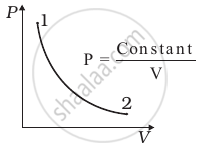
Out of the following diagrams (figure), which represents the T-P diagram?
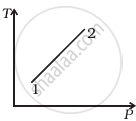 (i) |
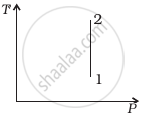 (ii) |
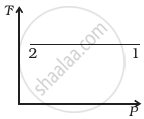 (iii) |
 (iv) |
In the figure shown here, the work done in the process ACBA is ______.
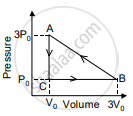
In a certain thermodynamical process, the pressure of a gas depends on its volume as kV3. The work done when the temperature changes from 100°C to 300°C will be ______ nR, where n denotes number of moles of a gas.
